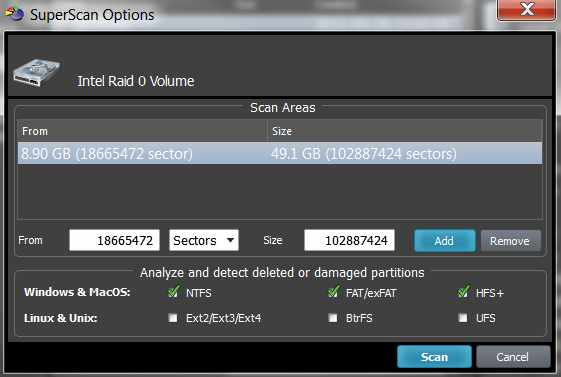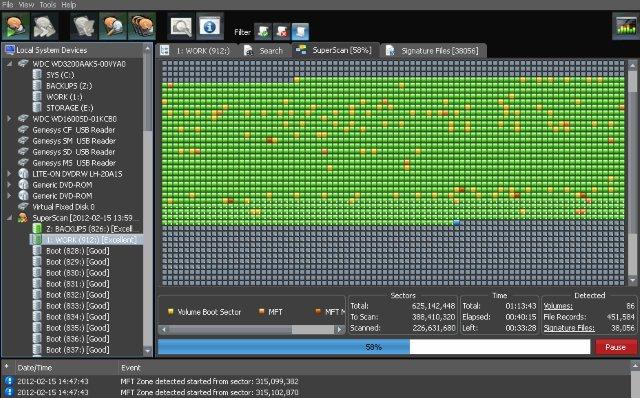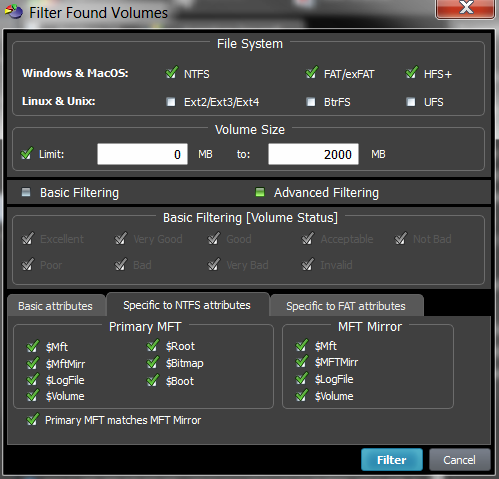How to use SuperScan to analyze deleted and severely damaged volumes
Use SuperScan when trying to recover a partition or logical drive that you know has been deleted or damaged and cannot be detected by QuickScan.
Another reason to use SuperScan is when the volume has been quick-formatted, or disk's surface has been heavily overwritten by other data, so you are not able to find your deleted data using QuickScan.
SuperScan processes the whole surface of the physical device searching for all possible logical drives and partitions, whether they are live, damaged or deleted.
If a partition cannot be found, SuperScan keeps searching. SuperScan reads each disk sector and looks for not only the boot sector, but also tries to reconstruct the drive structure, based on residual clues to the drive's system structures that remain on the disk surface. This is a very slow process and it usually gives much more results than QuickScan.
To run SuperScan:
- In the Local System Devices list, select a physical device, or a volume that contains your data. It may be a Fixed Disk, USB external or Removable Disk, Memory Card, and even a Floppy Disk.
- To open the SuperScan Options dialog box, do one of the following:
-
In the toolbar, click SuperScan

-
Right-click the physical device node and choose SuperScan from the context menu
-
Execute SuperScan command from Tools menu

-
The From and Size fields contain the currently selected object's geometry in sectors. You can switch the geometry display to other units (Bytes, MB and GB) using the drop down combo box. If you click Scan now - this area will be scanned by default.
-
To select a disk's area manually, type the starting sector number in the From field and the number of sectors in the Size field. If you need several areas to be scanned, define an areas parameters and click the Add button, then type another areas parameters and click the Add button again
-
In the Analyze and detect deleted or damaged partitions area, select the check boxes next to the partition types that you want to look for. Clear the check boxes next to the partitions that you do not want to look for. If you select all partition types, the scanning takes a longer time, however you may find more recoverable partitions
-
Click Scan or press Enter to start SuperScan process.
-
The statistics and progress bar appear underneath the scanning area. To stop the SuperScan at any time, click the red Pause button at bottom of the dialog, or choose Pause SuperScan from the context menu. If SuperScan has been paused, you may resume it by clicking the Resume button at the bottom of the dialog or by choosing Resume SuperScan from the context menu. If you have saved paused SuperScan results you can resume the SuperScan later on, after loading the SuperScan results - even after re-boot, or on another machine which has the same HDD/USB disk attached

- For each SuperScan process a new virtual folder named SuperScan [YYYY-MM-DD HH:MM:SS] has been added to the Local System Devices list. The contents of this folder is displayed in the tree (left panel) as well as in the Volumes tab (right panel). You may treat the SuperScan virtual folder and its contents the same way that you treat other device nodes in the list.
Inspecting SuperScan results
SuperScan can be a long process. You can check the estimated run time displayed on the status panel at bottom of the Scanning Area. You can wait until SuperScan finishes, or you can inspect and manage found partitions (volumes) "on-the-fly":
- Click the volume in the tree (left panel) to highlight the volume position in the Scanning Area (right panel)
- Right-click the volume and choose Properties from the context menu to check the integrity of the volume and the attributes which have been detected
- Double-click the volume, or choose QuickScan from the context menu - to scan the volume, browse its folders, view files and so on
- You can preview files from the found volume while SuperScan is still in progress
You can inspect the content of the file by selecting the file and clicking Preview toolbar button, or executing Preview command from the context menu, or by pressing Alt+P key combination.
After you complete a SuperScan, you may find hundreds of partitions. Volumes having different locations and size, may have been created and then deleted at different times on the device being scanned. If you have virtual VMware workstation profiles (from VMware, Inc.) or VirtualPC profiles (from Microsoft Corp.), these files also contain partition information.
Moreover, if what remains of damaged disk structures is not enough to define all of the necessary partition parameters, SuperScan uses complex algorithms to project the most probable parameters and, instead of displaying one partition could display 10-20 partitions having different sizes, offsets, cluster size and so on. This does not mean that SuperScan creates a lot of garbage.
This means that among these projected partitions most likely will be the one you've lost, and most likely you'll be able to find and recover your data. So, if you cannot find your data on the volumes having Excellent or Good recovery status, it is still recommended that you wait until SuperScan finishes and then inspect all found volumes once again.
Filtering SuperScan results
To reduce the amount of work, you may use a filter so that you are working with a smaller set of data. After the SuperScan, all detected volumes are displayed. When you change the settings in the filter dialog box, you can display only selected types of volumes.
To filter SuperScan results:
- After running SuperScan, select the virtual folder with the name SuperScan [date time stamp]
- Right-click the node. From the context menu choose Filter... The Filter Found Volumes dialog box appears.

-
To select the types of file systems to display, in the File Systems area, clear the check box beside the types that you do not want to display. Only the selected types of file systems data will be displayed
-
To display only those partitions within a specified size limit, in the Volume Size area, indicate the minimum and maximum sized partitions in Megabytes (MB). Only those partitions within the specified range will be displayed
-
To use basic filtering parameters, click Basic Filtering. To select displayed partitions based on partition status, in the Basic Filtering [Volume Status] area, clear the check box next to each partition status number that you do not want to display. Only the selected status ratings will be displayed
-
To use advanced filtering parameters, click Advanced Filtering and use the bottom section:
-
To restrict displayed results for found boot sector's attributes (file system-independent), in the Basic Attributes area, select the check box beside all the types of data that you want to display
-
To restrict displayed results for NTFS-specific parameters, in the Specific to NTFS attributes area, select the check box beside all the types of data that you want to display
-
To restrict displayed results for FAT-specific parameters, in the Specific to FAT attributes area, select the check box beside all the types of data that you want to display
-
-
Click Filter to set up a filter for all volumes found by SuperScan
Storing and loading SuperScan results
Depending on the size of the drive that you are scanning, it can take a long time to scan partitions. On large or damaged drives, it can take hours.
If you have to exit Active@ Partition Recovery for any reason, it would take a long time to scan the partition again. So that you don't lose the information that you have scanned, you may save the SuperScan results to a file. When you open Active@ Partition Recovery, opening the saved results file takes much less time.
If you decide to stop the SuperScan process, it is easy to continue scanning from the point that you stopped. After SuperScan has stopped, you may save the SuperScan virtual folder results, exit and re-start the application, open SuperScan results and resume SuperScan from the last point. To continue scanning, select the SuperScan virtual folder and click Resume button on the right of the progress bar.
To save SuperScan results
-
In the Local System Devices list, select the SuperScan virtual folder and do one of the following:
- Right-click the device node. From the context menu click Save Scan Results...
- From the File menu, choose Save Scan Results...
-
In the Save Scan Results dialog box, type a path or browse to a folder where the scan results file is to be stored
-
Click Save.
To open SuperScan results
- From the File menu click Open Scan Results...
- In the Open Scan Results dialog box, browse to the file where you saved the scan results file
- Click Open 4 In the Matched Devices dialog box confirm the device name (HDD/USB name) to apply SuperScan results for.
Several devices might have the same name, for example, similar disks usually used in RAID arrays. In this case the order they appear in Matched Devices dialog matches the order devices appear in Local System Devices list. You may inspect your disks in Local System Devices list to know for sure which device to choose.
SuperScan results can be saved automatically. You can configure this option and storage path in General tab of product Settings:

